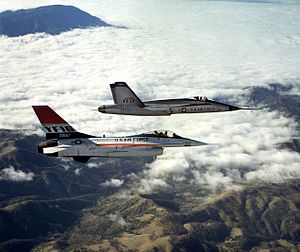Lightweight Fighter program
| Lightweight Fighter (LWF) | |
|---|---|
 |
|
| A right side view of a YF-16 and a YF-17, flying side-by-side, armed with AIM-9 Sidewinder missiles | |
| Project for | Light fighter |
| Issued by | United States Air Force |
| Proposals | Boeing, General Dynamics, Lockheed, Northrop, and Vought |
| Prototypes |
General Dynamics YF-16 Northrop YF-17 |
| Outcome | F-16 selected for production |
| Related programs | Navy Air Combat Fighter |
The Lightweight Fighter (LWF) program was a United States Air Force technology evaluation program initiated in the 1960s by a group of officers and defense analysts known as the "Fighter Mafia". It was spurred by then-Major John Boyd's Energy-Maneuverability (E-M) theory, which indicated that excessive weight would have severely debilitating consequences on the maneuverability of an aircraft. Boyd's design called for a light-weight fighter with a high thrust-to-weight ratio, a gross weight of less than 20,000 pounds (9,100 kg; half that of its counterpart, the F-15 Eagle), and high maneuverability. It resulted in the development of the General Dynamics YF-16 and Northrop YF-17. Late in the program, in 1974, with the promise of European sales, the Air Force changed the program name to Air Combat Fighter (ACF), and committed to purchasing 650 models of the YF-16, adopted as the F-16 Fighting Falcon. The U.S. Navy adopted a modified version of the YF-17 as the F/A-18 Hornet.
Project Forecast, a 1963 Air Force study, attempted to identify future weapons trends and "certain high-priority areas for research and development (R&D), recommendations based on the greatest potential payoff for the future." The report strongly suggested that future air combat would be carried out primarily by long-range missile fire. Future "fighters" would be designed primarily for long range, high speed, and equipped with extremely large radar systems in order to detect and engage opposing fighters at beyond visual range (BVR). This made them much more like interceptors than classic fighter designs, and led to increasingly heavier and more technologically sophisticated designs – and thus costlier.
...
Wikipedia
